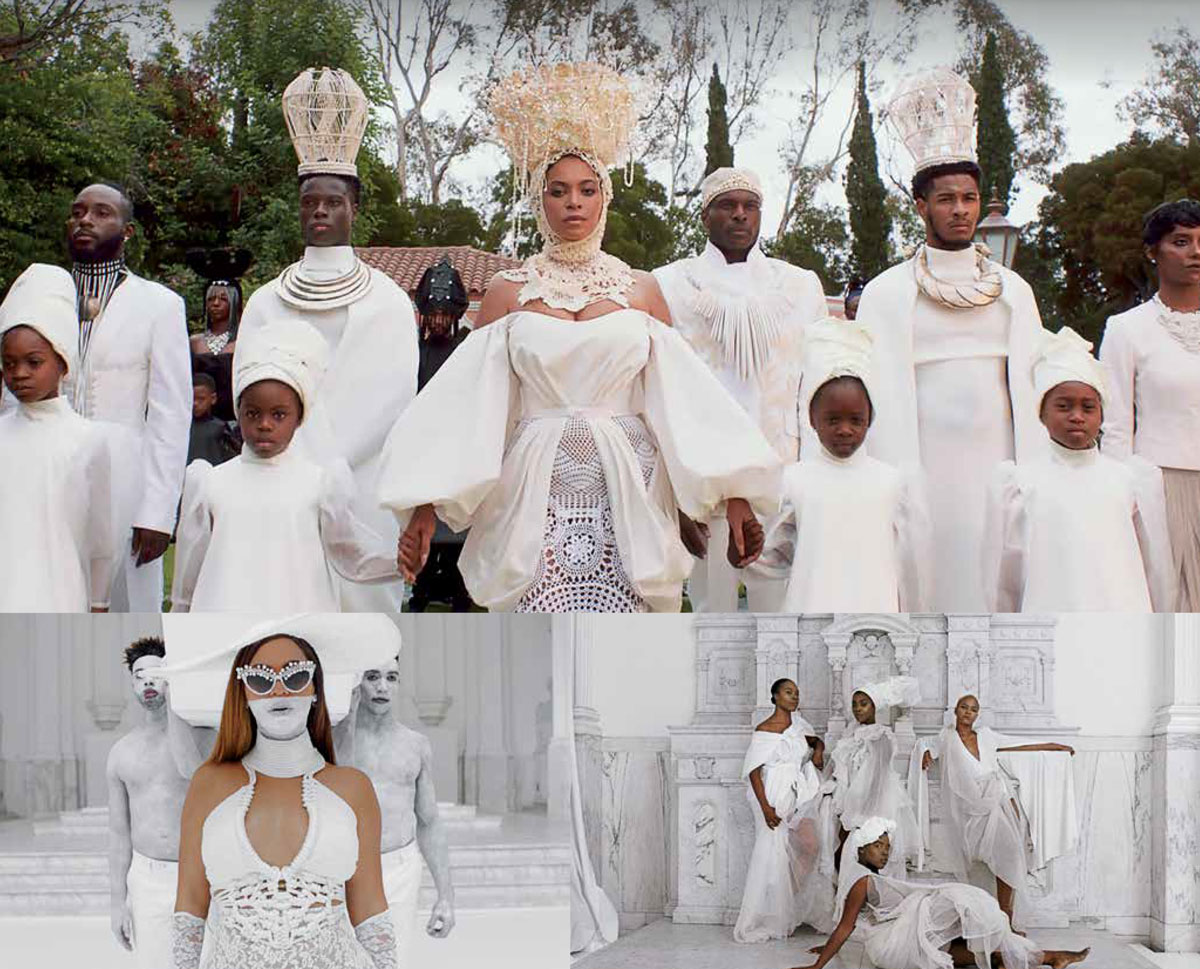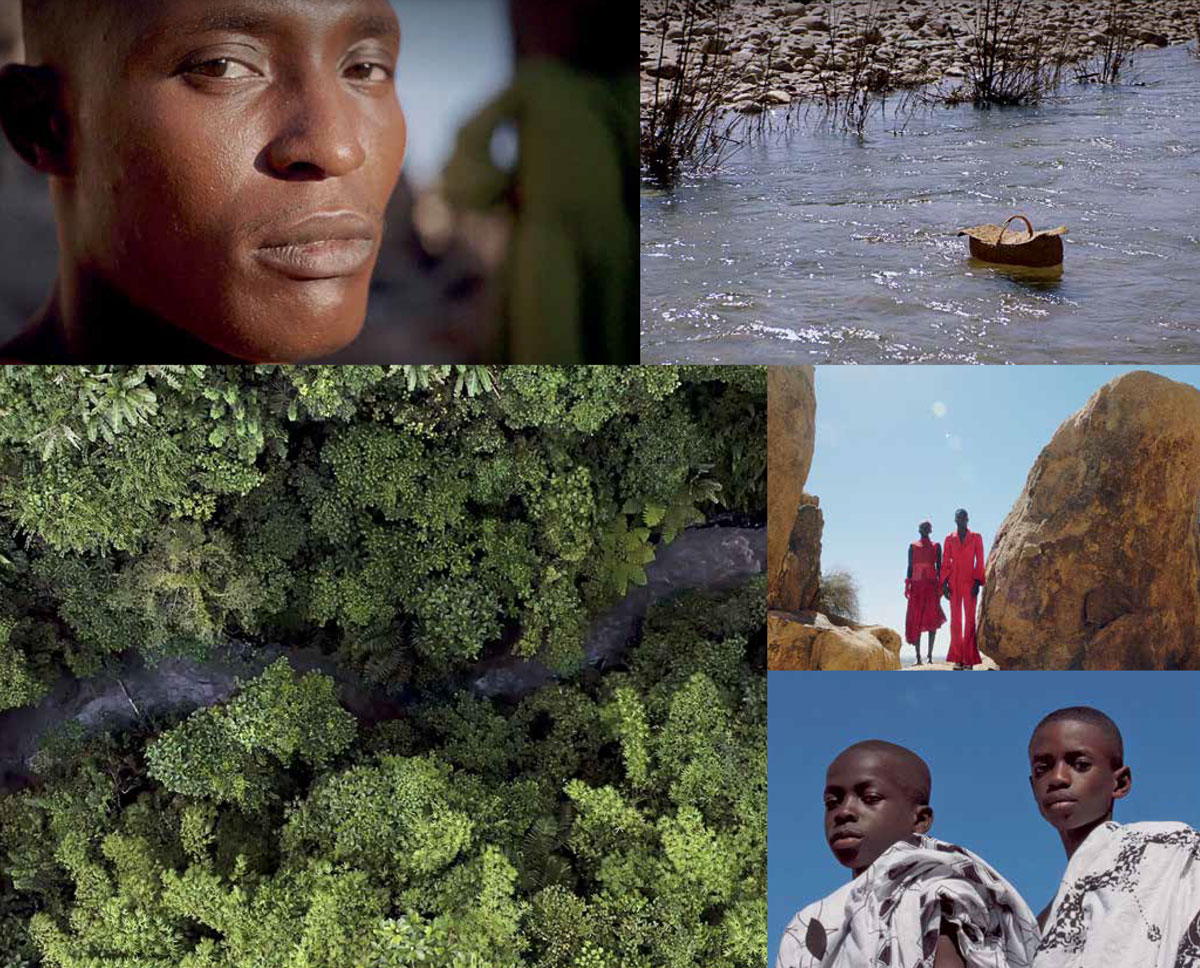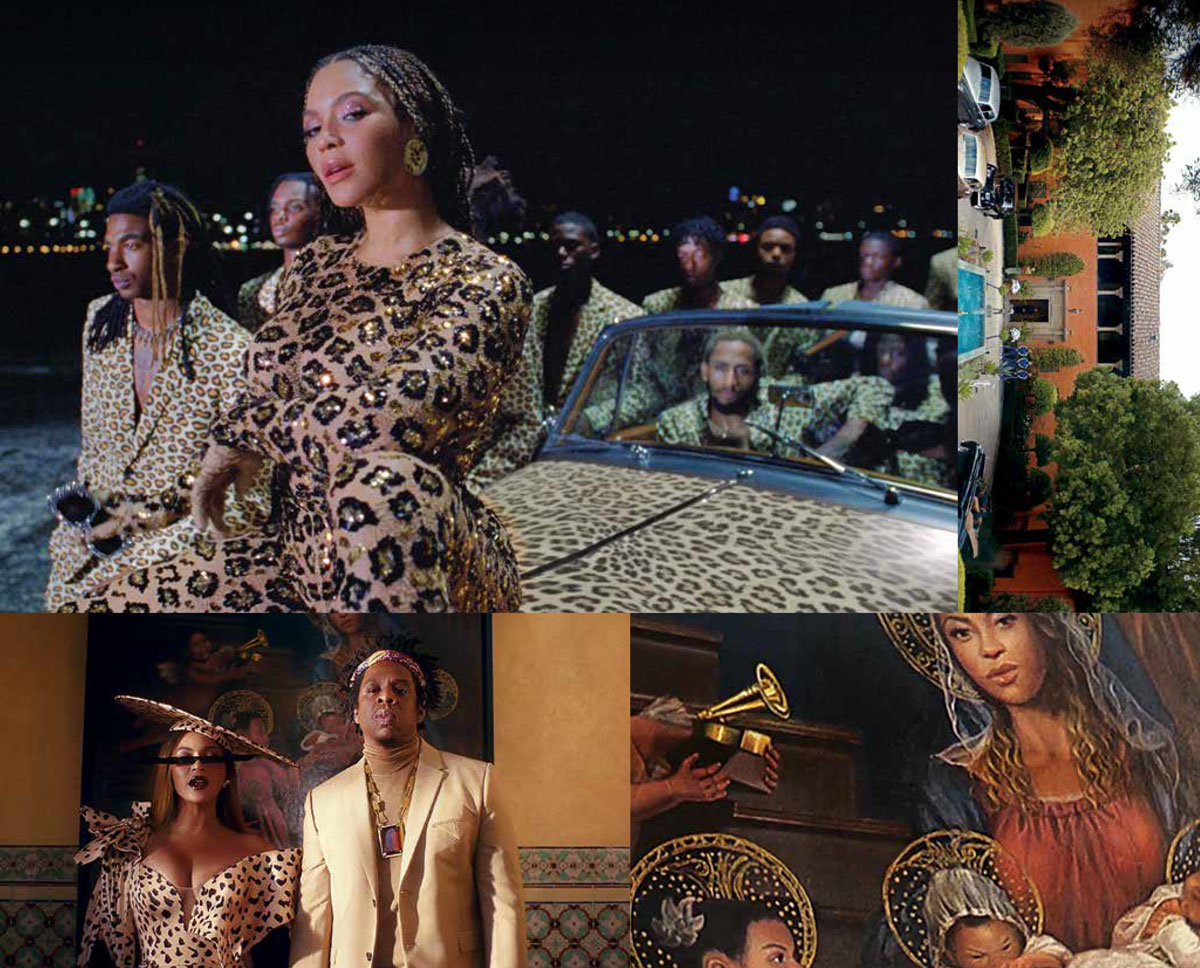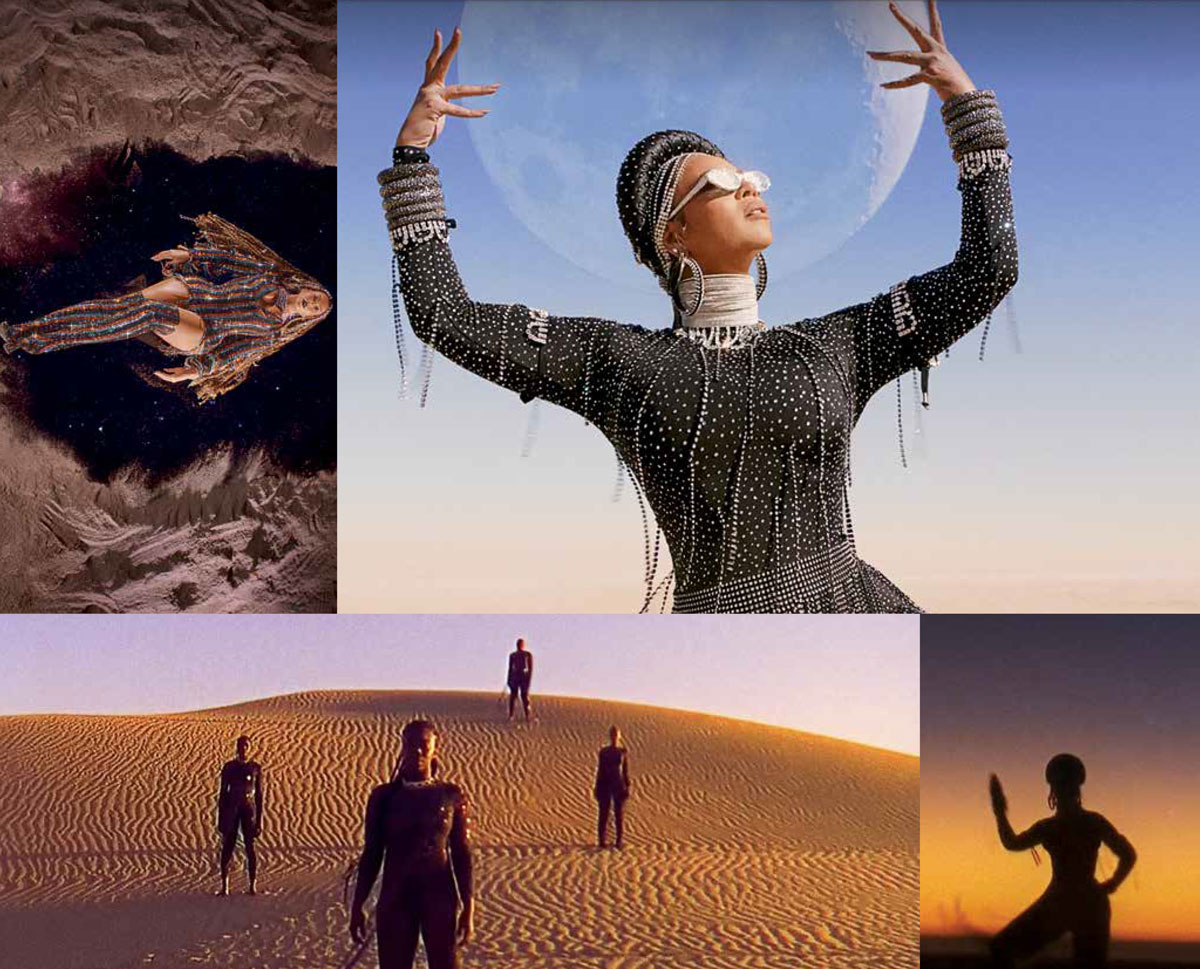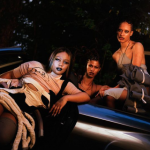Black is king?
Publicado em: 21 de December de 2020You are welcome to come home to yourself. Let Black be synonymous with glory.
The visual album Black Is King by the American singer Beyoncé Knowles-Carter consists of a sequence of video clips from her album The Lion King: The Gift, created as the soundtrack to the new version of the film The Lion King (2019), directed by Jon Favreau. Black Is King is also a movie that reenacts the story of Prince Simba, the hero of the Lion King, following his return to reign and the redemption of his identity as the leader of his community. Black Is King is also a greater mythological and spiritual narrative: of the black diaspora peo- ple to the fabled return to our roots.
Everything you see exists together in a delicate balance.
There is a black baby in a basket floating in the current of a river. There is a black boy marked by white paint. By the seashore, Beyoncé receives them and takes them in like a spiritual guide. The ancestral time and the hero’s journey meet and cross in the assembly of images.
In Beyoncé’s Afrofuturist and Pan-African reading of The Lion King, Simba’s going back home and the reconstruction of both his identity and fate complement themselves with the metaphorical return of the black diaspora to its ancestry. A spiritual return, of healing and telling a fable, to a world unmarked by anti-black feeling.
In its Afrofuturist inspiration, this twin narrative uses what Kara Keeling, in her book Queer Times, Black Futures (2019), called a “cosmic imagination” or “a mobile, fugitive perception of the interconnectedness of all things, which does not insist upon a universal system of commensuration, but instead allows for every thing’s right to opacity.” Thus, the various references to the cultures and peoples of Africa and the diaspora are freely articulated in space, with transcontinental relations, and in time, by going through an ancestral past, a glorious present and a cosmic future. According to Keeling, what is built is a “future of the past,” an imagined narrative beyond the promises of black futures not made by modernity and its combo combining colonization and enslavement.
The orishas hold your hand through this journey that began before you were born. We never forget to say thank you to the ancestors, noble and royal, anointed, our blessings in the stars.
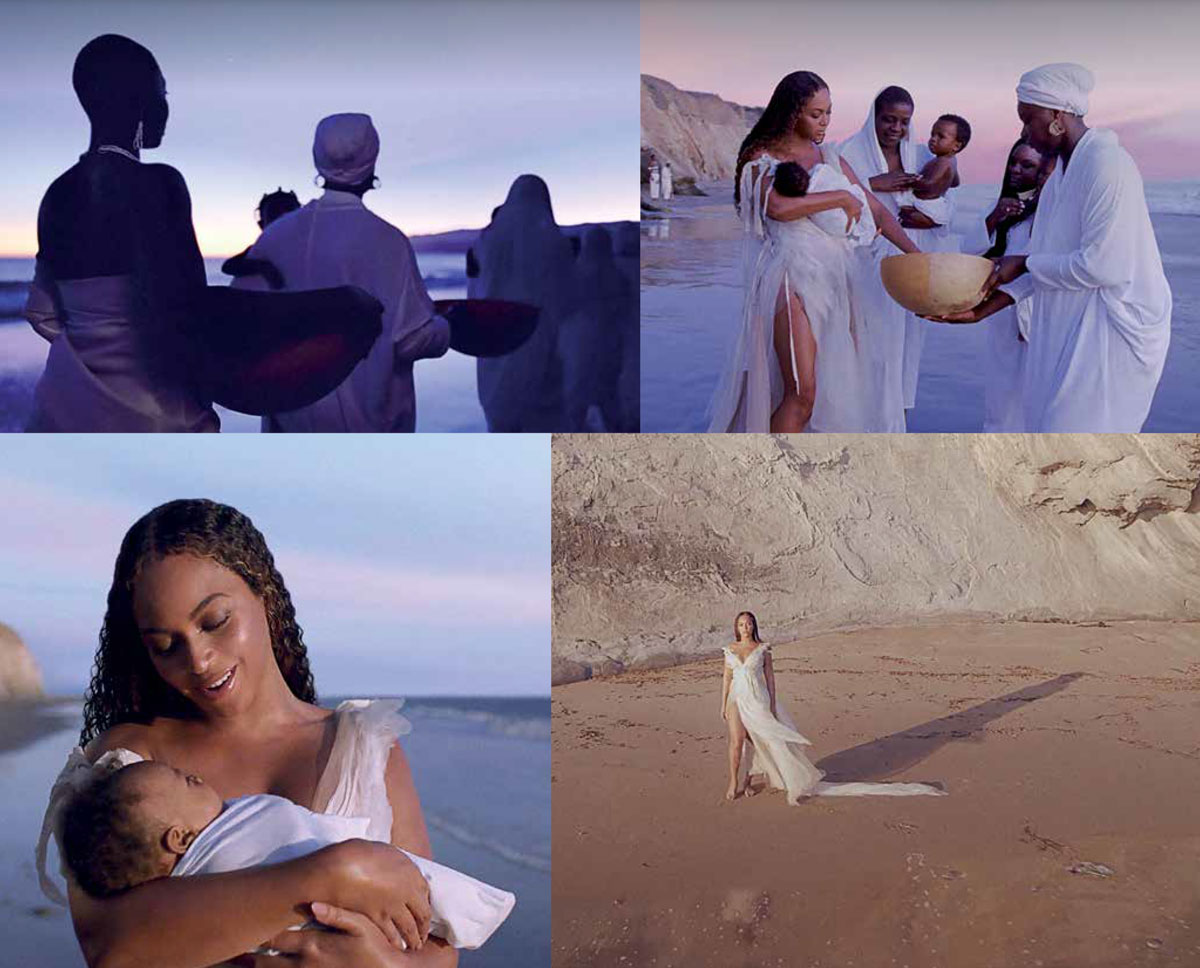
Although connected, the two narratives follow different timelines – a linear time (the few years between Simba in his infancy and as a youngster), and the other cyclical (the endless quest for healing and black spiritual and geographic roots of exiled black people in the post-slavery society, surviving in a world marked by anti-blackness). One ends, the other repeats.
Therefore, to think of the political and esthetic legacy of Afropessimism and Afrofuturism involves, first, recognizing the legacy of colonialism which instituted anti-black sentiment as a way of imposing white supremacy. In A plantação cognitiva [the cognitive plantation] (2020), artist Jota Mombaça evokes the figure of the Plantation to speak of the dehumanizing slave camps, this “specific approach to the subjection of the black races in favor of reproducing a productive system that continues the work of slavery as it makes it match processes for extracting value with a regime of anti-black violence.”
Politically, the survival of slavery not only impacted the black population, but effectively shaped the direction of modernity. Researchers into race relations, including Aníbal Quijano, Achille Mbembe, Saidiya Hartman, Jared Sexton and Frank B. Wilderson III, share the premise that the modern civilizing project gave the blacks the function of the other, the reverse of the position of the subject, to reaffirm the humanity of non-blacks. This antagonism through race allowed the adoption of supposedly universal ideals by western society (for example, merit, citizenship, freedom, liberalism and the very notion of subject) that implicitly or explicitly exclude us, blacks, reducing us to a non-human condition.
It is only when the already grown-up Simba begins to reconnect with his ancestry that we see the origin of the baby left in the basket, in the song “Otherside”. In this myth of the orphan of African diaspora’s origin, we see a mother collapsing who, in the face of a world structured on the dehumanization of blackness, launches her son to an uncertain destiny, perhaps betting on a future “after the future,” foreseen beyond the catastrophe of a world in ruins.
Afrofuturism and Afropessimism are concepts that allow a reinterpretation of the idea of dystopia in the process of reformulating the black experience. In the context of Afropessimism and its relationship with the diaspora, the apocalypse is a constant reality in black lives and it needs to be acknowledged daily. This is because the afropessimists critically revisit the ideologies that have structured the process of enslavement of thousands of people kidnapped from Africa and taken to the Americas. In this rethinking, the underpinning characteristic of black slavery was not forced labor, but an organized and ruthless project to dehumanize the enslaved – social death in life. Although working conditions have changed after the abolitions of slavery, black non-humanity as a form of social organization has gone through only subtle changes. That’s why the narratives of the speculative fiction of Afrofuturism, even when they portray alternatives of overcoming, must deal with the scenario or a dystopian ethos of colonization as a premise.
These movements gain esthetic and political features as they offer possible perspectives that extend beyond a past of colonial modernity. The American cultural critic Mark Dery was the first to formulate the concept of Afrofuturism in 1993, when he identified the absence of black creators in the technological culture of science fiction emerging in the late 20th century. According to Dery, Afrofuturism, as narrative and speculative esthetics, opens up a space for black tecno-political experimentation extending not only into literature, but also into music, dance, the audiovisual arts and other forms of artistic expression.

Therefore, to think of the political and esthetic legacy of Afropessimism and Afrofuturism involves, first, recognizing the legacy of colonialism which instituted anti-black sentiment as a way of imposing white supremacy.
The baby is Moses. The baby is the ancestral rebirth of Simba. The baby is every black in the diaspora who lost their mother and travels the impossible journey back to the slave trafficking routes across the Black Atlantic to the continent. A journey of recovery and remembrance of the impossible, as Saidiya Hartman teaches us in Lose Your Mother: A Journey Along the Atlantic Slave Route (2007).
Child of dust, return to the river. Your roots and your story will be reborn. We’ve been conditioned to be inside of a box. We’ve been created with this image that Black men are supposed to be this way. And I feel like we’re kings.
The black boy is king. The black boy is heat of the galaxy sprinkled with stars.
When the black boy, now an adult, is reborn, a new world imagines itself with him – and with her. Is it a world founded on love, by meeting with Nala, his childhood love? Or a world founded on power, for disputing the throne with his uncle?
Is it possible to imagine again a world between linear time and cyclical time, the ancestral and the land, the cosmological and the human, spiritual belonging and the trauma of the black diaspora by enslavement, colonization and anti-blackness? Or is it precisely the fact that black people and queers remain “an enigmatic shadow cast on the hu- man project,” as argued Tavia Nyong’o in Afro-Fabulations: The Queer Drama of Black Life (2018), which opens up the possibility to afrofabulate humankind “completely different from humankind as we know it today?” And how different from what we know can a reign of patriarchal organization be?
When the world turns its back on you, you turn your back on the world.
Only embrace what’s next
And turn the “what” into “so what?”
Black Is King plunges into a free and creative delirium when Simba dreams of a luxurious and extravagant life in an opulent mansion, with expensive objects of art and decoration, in the video for the song “Mood 4 Eva”. It is also the moment in which the hero’s spiritual guides are literally left by the side of the road, marking a fracture between the ostentation of material wealth and spiritual balance.
The segment marks the ambivalence of Beyoncé’s project, between valuing black artistic creations and the validation of Christian iconography and the renaissance canon, claiming black presences inside this hegemonic representation. On the walls and in the gardens of the mansion, there are images of the series Beauty World, by Derrick Adams (2019), sculptures which mix Art Nouveau with the cultural traditions of Benin, made by Woodrow Nash in the style that he baptized African Nouveau, the biblical retelling by Conrad Egyir created from pop art and the Ashanti culture in Paragons of Rest, among other works by black artists from Africa or the diaspora.
On the same walls, the Knowles-Carter family is the protagonist of a series of paintings in the Renaissance style, which re-enact the Christian mythology. The figure of Beyoncé as mother and divinity, guide and source of the afro-diaspora, appears as a recreation of Our Lady. As Alex Greenberger points out in the magazine Artnews, “Beyoncé’s reliance on the Madonna trope can be seen as part of a larger project to recontextualize these art-historical tropes – typically reserved for white women – for a new audience.”
This delirium of world imagination in Simba’s dream makes evident the conflict between the black creation of their imaginaries and the black reappropriation of the symbols of the Eurocentric history of art.
Commenting on the work of the philosopher Frantz Fanon, Jota Mombaça points to an inevitable confrontation: “It is Race before anything else, and not Racism, which is at the heart of Fanon’s analytical approach, so that the antidote to this pathology of modernity (Racism) not only relies on the ‘valuing’ of blackness, but on an intensive abol- ishing of Racial as a descriptor of difference and of Value as a principle of ethics.”
Anti-blackness confers a dystopian character to black experience. It reorganizes the possibilities for expression by requiring us necessarily to refer to the horrors of colonial slavery and its consequences, including in the present. Be they mass incarceration and the police violence that kills us daily, be it a state policy of controlling and disposing of our bodies, be it also the social conscience which, taken by an anti-black feeling, does not allow black lives to matter. An ideology that founds whiteness as a system of power and that prefers to read the plea for help as a threat instead of recognizing an original and systemic inequality. It is upon this inheritance of anti-blackness that Afropessimism is based; not just on racism and daily discrimination, but on our own objectification and dehumanization by the very idea of race.
By dealing with the art produced in the African continent, a fundamental reference in Black Is King, the Cameroonian historian Achille Mbembe proposes the term “Afropolitanism” to refer to a certain ethos to be found in music, the visual arts, dance and especially in the literature produced in the last forty years. “The object of artistic creation already no longer consists in describing a situation in which someone becomes an itinerant spectator of their own life because they see themselves reduced to impotence by historical accidents. On the contrary, it is manifest that the man torn into pieces rises slowly, releasing themselves from their origins.”
For Mbembe, the release from origins is an allegory which is conspicuously present in the works of several artists and authors, as is the case of the Malian writer Yambo Ouologuem. In Ouoluguem’s books, blackness and the idea of difference that is built by it need to be recalled so that, by refusing the orthodoxy of origin, they do not become an eternal mourning for the past, a “discourse of lamentations.”
Mbembe argues that after Ouologuem, the principle of loss and grief is replaced by excess and exaggeration. “Reality (whether it is concerned with race, the past, tradition or, better still, with power) does not present itself only as that which exists and is susceptible to representation, to figuration. It is also that which covers, envelopes and exceeds what exists.”
Wesley Morris, the film critic, wrote in the New York Times, complaining that the images in Black Is King adhere to “ancient music-video ideas of chaos, incoherence and looks.” With their rapid-fire editing and many changes of costume, image after image is tirelessly beautiful. Excessively glorious.
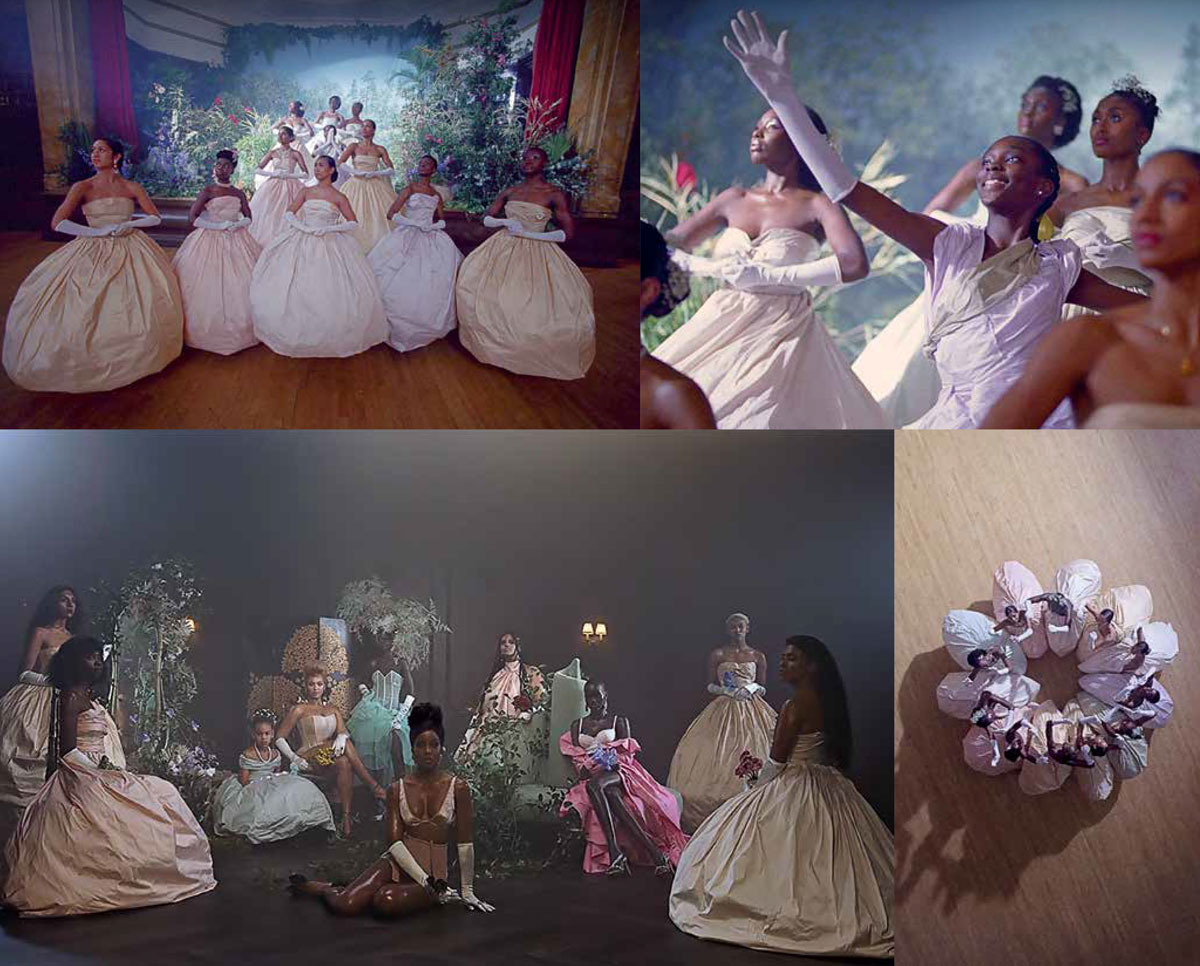
We have always been wonderful. I see us reflected in the world’s most heavenly things. Black Is King. We were beauty before they knew what beauty was.
Some carefully posed paintings lay the foundation stones of black glory and beauty in this world imagined without anti-blackness – a world without white people, with black life and dignity celebrated and loved. The weaving of the fable reaches its peak in the song “Brown Skin Girl”. Women whose skins are the most varied shade of brown show themselves in a choreography which, at the same time, looks back at us, perhaps questioning, “After all, why, even with all this splendor, won’t you love us?”
This sequence in the film is directed by the English artist and filmmaker Jenn Nkiru, whose short films Rebirth Is Necessary (2017) and Black to Techno (2019) stand out as contemporary Afrofuturist productions. The first film uses archive shots – from the jazz musician Sun Ra to the militants of the Black Panthers – in a rhythmic, visually poetic approach to imagining spiritual and cosmological rebirth to blackness. Her second work revisits the Detroit techno music scene, which is at the origin of the discussions on Afrofuturism at the beginning of 1990s, fusing black music, electronic music and science fiction.
It would be a better world for all of us if kings and queens realized that being equal, sharing spaces, sharing ideas and sharing values and sharing strengths and weaknesses, balancing each other out is how our ancestors did things and that is an African way.
Black beauty and glory are part of the splendor of the world imagined in Black Is King. The social structure of this idyllic black community looks to a pre-colonial past imagined from the diaspora of an Africa with kings and queens and yet oddly united.
Black Is King would be an afro-diaspora creation which separates Pan-African esthetic and political objectives, as the sociologist Zandria Felice Robinson explains: “The former [political objectives] seeks the unification of African countries to resist oppression, while the latter [esthetic objectives] collapses African cultures into palatable categories for sale,” she wrote in the magazine The Atlantic.
The fragmentation between a political Pan-Africanism and another esthetic is evident in the creative separation advocated by the writer Nnedi Okorafor between the speculative fictions that arise from a perspective of the diaspora towards Africa (Afrofuturism) and those concerned with the flow from the continent to the black diasporas (Africanfuturism). In an exemplary image, Okorafor takes as her starting point the adaptations and recent versions of the narratives of the Black Panther hero in comic books and in the cinema. While in Ryan Coogler’s movie Black Panther (2018), Wakanda opens up to the world by building its first outpost in Oakland, in the United States, in Black Panther: Long Live the King (2017), a graphic novel that the author wrote with Aaron Covington, the first outpost of Wakanda is in a neighboring country in Africa. A difference in perspective and point of departure (the continent or the diaspora) which makes visible the order of geographical priorities and political and economic solidarity, something relevant in a context of the financial and cultural hegemony of the USA over the other nations of the world.

É possível voltar a imaginar um mundo entre o tempo linear e o tempo cíclico, a ancestralidade e o terreno, o cosmológico e o humano, o pertencimento espiritual e o trauma instalado na diáspora preta pela escravização, colonização e antipretitude?
In the Afrodiasporic perspective of the Americas, Africa will tell a fable like this origin or lost mother (placing her baby in the crib in uncertain waters). An origin that is never fully recoverable after centuries of violent suppressions, which organized the death of black society in life and the generalized anti-blackness. From the perspective of Africa, there is the danger of a wakandafication of the presentations of the continent, with its homogenization and essentialization in favor of the black money of American capitalism, as the black feminist historian Jade Bentil pointed out in reference to the fictional country.
In Black Is King, for example, interpretations of the use of the Afro-American flag created by David Hammons in 1990, which appears on the track “Already” to symbolize a Pan-African union, are ambiguous. The flag appears in the midst of an agglomeration of black men in a song which talks about remembering our essence and reconnecting with the ancestral plane. Actually, is everyone someone? Even a nobody? And a multitude of nobodies: can everyone be a king, or just subjects?
If it makes no sense, besides racism, to demand historical plausibility in a speculative narrative, what we ask from the fable creation in Black Is King is how to imagine beyond the hierarchies of class, both in the past and the present. Or, as the Afro-feminist activist Judicaelle Irakoze formulates in an article entitled Why We Must Be Careful When Watching Beyoncé’s “Black Is King”: “One could wonder are Africans humans with dignity if they are not kings and queens, draped in gold and diamonds? Are we saying our ancestors shouldn’t have been enslaved because they were kings and queens and not simply because they were humans?”
Systematically, we had a lot taken from us. Being a king is about taking what’s yours, but not just for selfish reasons, but to actually build up the community.
In this paradox between linear and cyclical times in the movie, some images intensify the encounter or the mismatch of the two narratives, such as the moment in which Simba is recognized by Rafiki as the heir to the throne and ascends to his divine and monarchic origin. His body levitates toward the heavens, in the space of a circular structure building. There are, at the same time, straight lines that connect the earth and the sky lit by the rays of the sun – the path taken in the journey of the prince who is reunited with himself and with his origins – and, around these lines, seen in perspective from bottom to top, circles are formed by the textures of walls and windows of the apartments, which are repeated until lost in the bright sky. These circles take us back to the black afrodiasporic experiences that collectively articulate both trauma and healing, the lost mother and the invented mother, to infinity – or until the end of the world founded on anti-blackness.
Having been filmed in the Ponte City skyscraper in Johannesburg, South Africa, the image is even more emblematic of the paradoxes of black existence in a world marked by anti-blackness. The modernist 54-storey residential building was built in the 1970s to represent the cosmopolitan, opulent and cool (besides white) nature of the South-African city. However, it soon became a symbol of the decadence of white dreams of apartheid: located too close to the black area of the city, over the decades the skyscraper became a housing project, affordable for black families, students and immigrants.
Its atypical architecture and its reputation as a dangerous place, of drugs and crime, because mostly black, has become part of the dystopia depicted in fiction movies that speculate about the present – the building served as a location for films, such as District 9 (2009) and Resident Evil: The Final Chapter (2016). The daily experience of black people is taken literally as a post-apocalyptic experience in the hegemonic imaginary. However, in Black Is King, Ponte City is seen not as an exotic location, but a sacred place – a path to the divine. The path revolves around Simba, but is shared by the apartments’ inhabitants, and forms circles to infinity.
There is something about royalty.
There is something about walking with your head up and not disrespecting your crown by bending your neck.
To think of the composition of the images in Black Is King is to return constantly to the central shots of the work’s star and creator. In the cosmos, in the desert, at sea, in the forest, Beyoncé is the constant presence in the center of the frame, in compositions which are usually symmetrical and balanced, reinforcing the philosophy of balance of earthly and spiritual forces that the movie announces. In the metaphor of the mother who raises the black diaspora’s children, the centralization of Beyoncé’s points to a unifying leadership of the Pan-Africanist reunion. At the same time, this centralization values individual paths of black excellence in a world of anti- blackness, where possible futures depend on the “success” of exceptional blacks.
After all, there seems to be more than a difference in the temporality between the two narratives: how to connect them? On the one hand, the mythological narrative founder of Black Is King, which bets on black survival after the catastrophe against the adversities of turbulent currents; on the other hand, the journey of the prince hero, which resolves itself by restoring a hierarchy of power and class in the black community – the same hierarchies that destroyed the world.
Afrofuturism does not reject the premise of anti-blackness and shows a way of producing and claiming ideals for the future by means of speculative fiction, telling fables, reimagining and merging the past, present and future to subvert the boundaries between dystopia and utopia. In this way it is possible to reinvent another historical flux not touched by anti-blackness – a flux not necessarily pre-colonial, which refers to an original version of history, but properly anti-colonial. ///
BEYONCÉ KNOWLES-CARTER (USA, 1981) is a singer, songwriter and music producer. She created the visual albums Lemonade (2016) and Black Is King (2020). She has won numerous Golden Globe and Grammy awards, among others.
KÊNIA FREITAS holds a PhD in Communications and Culture from UFRJ (Federal University of Rio de Janeiro). Professor, critic and curator of cinema, she researches Afrofuturism and black cinema. She was the curator of the film series Afrofuturism: Cinema and Music in an Intergalactic Diaspora (2015).
JOSÉ MESSIAS holds a doctorate degree in Communications and Culture from UFRJ (Federal University of Rio de Janeiro) and is an adjunct professor in the Social Communication/ Journalism course and the Postgraduate Programme in Communications at the Federal University of Maranhão, the Imperatriz campus.
IMAGES: FRAMES FROM THE FILM BLACK IS KING (2020), BEYONCÉ, CO-SCRIPTED BY BEYONCÉ KNOWLES-CARTER, YRSA DALEY-WARD, CLOVER HOPE AND ANDREW MOR- ROW, WITH QUOTES FROM WARSAN SHIRE’S POEMS
+ Queer Times, Black Futures, by Kara Keeling (NYU Press, 2019)
+ Afro-Fabulations: The Queer Drama of Black Life, byTavia Nyong’o (NYU Press, 2018)
+ Sair da Grande Noite: ensaio sobre a África descolonizada [getting out of the Great Night: essay on decolonized Africa], by Achille Mbembe (EditoraVozes, 2019)
+ Lose Your Mother: A Journey along the Atlantic Slave Route, by Saidiya Hartman (Farrar, Straus and Giroux, 2007)
Tags: Afrofuturismo, Afropessimismo, Diáspora africana

